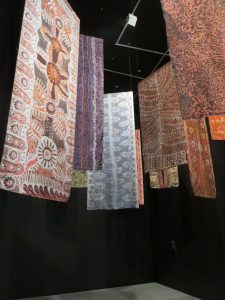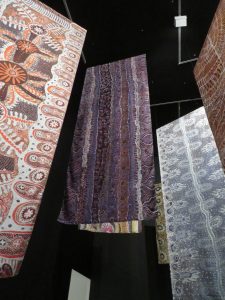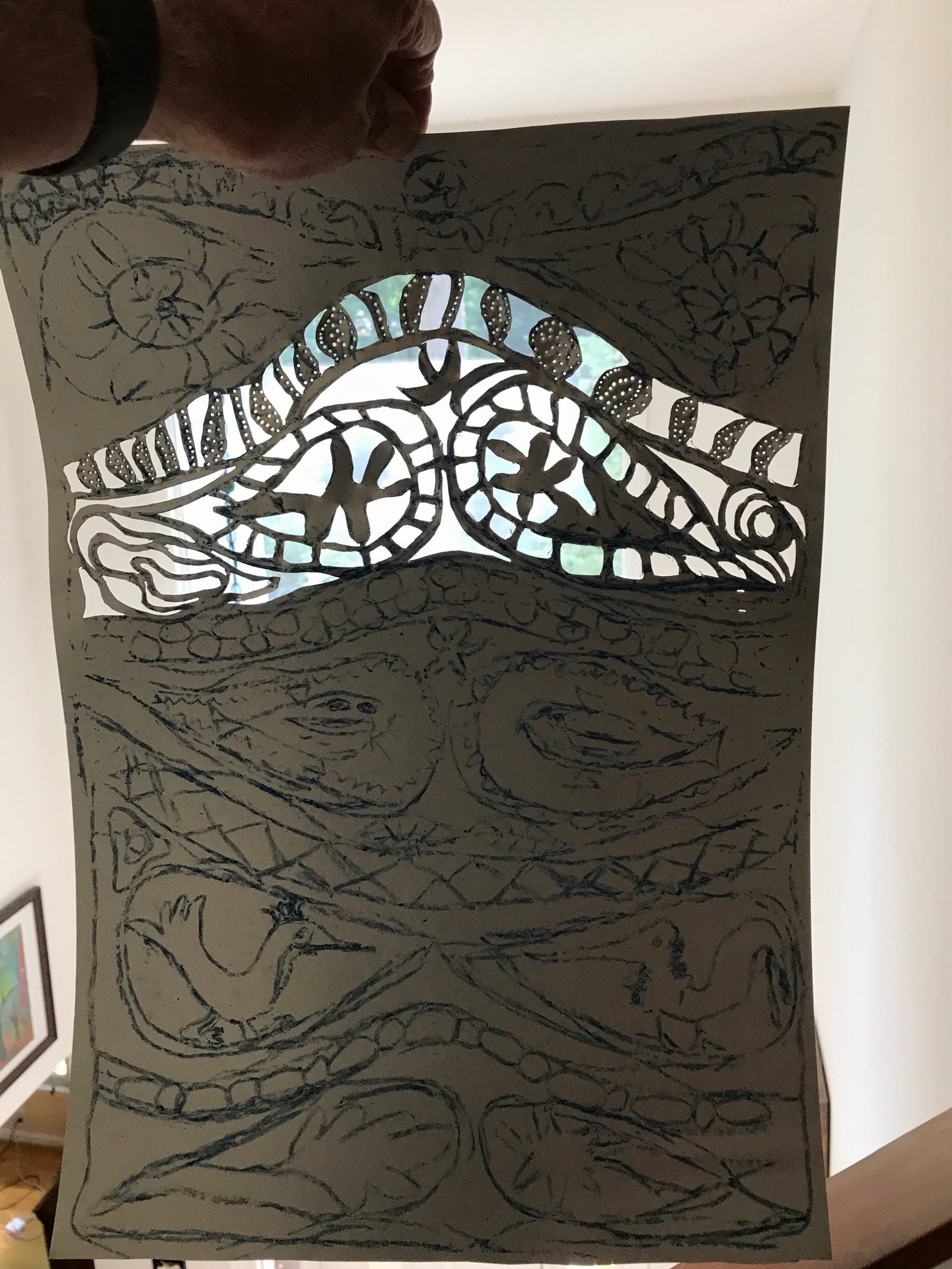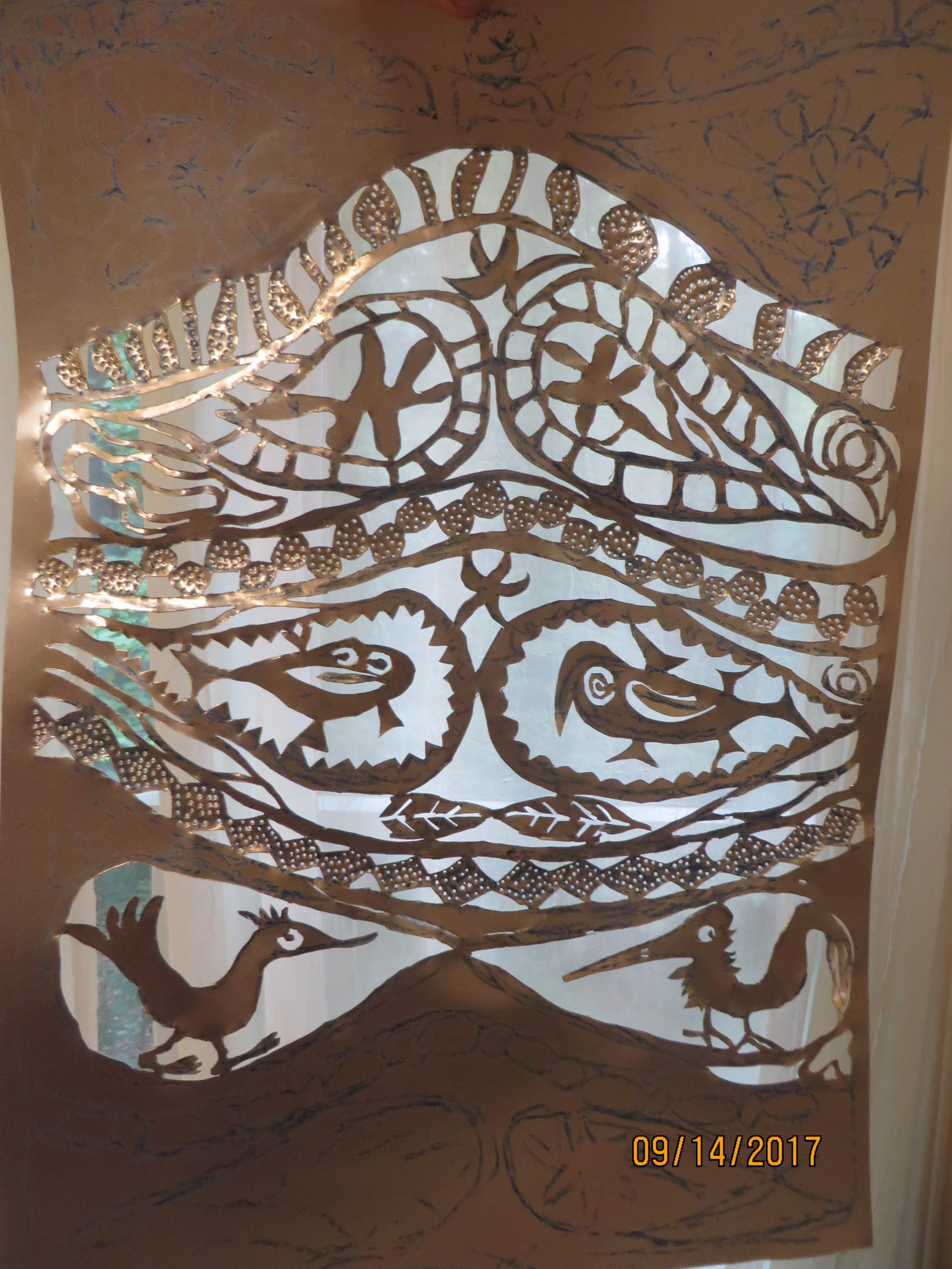PURELY ORNAMENTAL, 2017
PURELY ORNAMENTAL, 2017
(2018 winner of Public Choice Award in the 4th Annual Juried Exhibition “Resolutions 2018” at Hillsborough Gallery of Arts)
This is indeed intended to be a purely ornamental piece. There is no story to tell in this work. But there is a story to tell about its inspiration. And the inspiration is again Australian, but not only. During my visit in 2016 to the National Gallery of Victoria at Melbourne, Australia, at the very end of the Indigenous Collection they have a room filled with textiles, banners and rugs. These were of an overwhelming variety and color and beauty of design. They all have been largely abstract and purely ornamental.
Textile room in National Gallery of Victoria, Melbourne, Australia
One textile has attracted my attention in particular, called “Raiki wara” or “ Long Cloth” of 1989 by Tjariya (Nungalka) Stanley, born c. 1939 in Wingellina, South Australia of the language group Pitjantjatjara. She was active in a known center of arts of indigenous people of Ernabella, South Australia. Interestingly, this piece of cloth is made with an Indonesian, widely known, but not necessarily identifiable, technique of batik. The name of this technique is “derived from the word ‘ambatik’ which translated into English means ‘a cloth with little dots’. Clearly, “little dotes” are my love.
They are, either independently or by sharing with Indonesian culture, a well distinguishable technique, part of Australian modern indigenous culture. Apparently, the suffix ‘tik’ means little dot, drop, point or to make dots. I was able to find a professional photo of the object in the Museum’s nearly 4000 objects indigenous collection database.
Left: “Raiki Wara” meaning Long Cloth, Batik on silk, by Tjariya (Nungalka) Stanley, 1989, at Ernabella Art Center, South Australia; in collection of National Gallery of Victoria, Melbourne, Right: Long Cloth, Batik, by Yilpi Adamson, 2017, at Ernabella Art Center, South Australia; in collection of Museum of Applied Arts and Sciences
This 1500 year old technique with strong roots in historical batik still utilizes linear treatment of leaves, flowers and birds. The modern batiks however appear to have abandoned stiff guidelines that have inspired traditional craftsmen. This is also apparent in the use of more aggressive colors that modern designers employ. See an example above of a 30 – year younger production from the same location (the same art center) by an artist named Yilpi Adamson, of 2017, with the same title: the Long Cloth.
But the Australians were not the only inspirations for me in this work. First, my Polish background is permeated with the tradition of paper-cut-outs, at least 300-200 year old. That includes pretty schematic in the set-up, but nonetheless very creative, in detail, structures based on a tree concept paper-cuts filled with birds, leaves, animals, as copied below from a wonderful monograph on Polish Folk Cut-out Art by Aleksander Blachowski, 1986, Muzeum Etnograficzne w Toruniu, Poland.
Polish paper cut-outs of 1970s (from Polish Folk Cut-out Art by Aleksander Blachowski, 1986, Muzeum Etnograficzne w Toruniu, Poland)
These cut-outs were ubiquitous in Poland in the last century. You would find them at the farmers’ markets, but also massively in the 1960s-80s in the art cooperative (Cepelia) shops of the period across the country.The set up was sort of formal, rigid, almost byzantine. I am sure that in my piece instinctively I followed that tradition.
Finally, from another end of the world, there comes an inspiration from the art of the native art of Mexico’s tribe of Otomi Indians from central part of Mexican highland. I became captivated by their art, when browsing in the art shop in San Diego, and came across their table runners. I bought one, perhaps less typical because monochromatic (left, below), while most of them are colorful and quite gay (right, below). Otomi’s production is quite distinct and these days also voluminous, but nevertheless have maintained the character, originality and individuality of the hand-made pieces.
Side by side
I have adopted a traditional design, and after a lot of hesitation and consultation, I elected not to color my cut-out, to, as my brother suggested, follow the more mono-chromatic tradition of paper cut-outs rather than that of textiles. There was a lot of fun cutting this piece, especially designing, and changing the dotted beads all over the place following the Australian tradition (see below). During cutting I was careless enough to brake off the left leaf in the middle, as can be seen below, for which I had to eventually glue in a replacement fragment.
In development













Piekne to jest Tomku! Twoje rownolegle zycie coraz bardziej fascynujace
Very nice!
Twoje “czysto dekoracyjne” wycinanki , Tomciu, są – dla mnie – pięknymi unikatami, mimo że powstały częściowo pod wpływem rodzimych, banalnych raczej symetrycznych wycinanek. Ale abstrahując nawet od samej ich techniki ,Twoje są bardziej subtelne, przemyślane – powiedziałbym “natchnione” tym wszystkim co Twoje spostrzegawcze oko zauważyło w naturze i sztuce rękodzielniczej wielu już krajów i co -dzięki Twojemu niezwykłemu talentowi – potrafiłeś oddać w tak pięknej formie. Podróżuj więc ile się tylko da, zwiedzaj muzea i podpatruj co kryje jeszcze ten “piękny nasz świat” a – co najważniejsze –
nie ustawaj w dostarczaniu nam nowych artystycznych przeżyć > Twoimi …magicznymi nożyczkami.
Tomku,
gratuluje wyobrazni, pomyslow i co tu ukrywac talentu!
Przepiekne. I dobrze, ze zostawiles jednokolorowe.
Jak kiedys przejdziesz na emeryture to masz drugi rownie udany zawod i mase satysfakcji.
keep it up!
baska